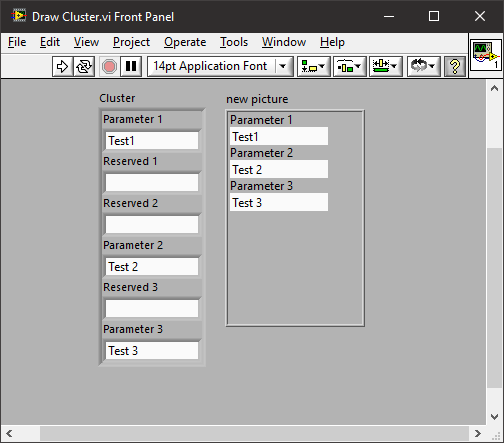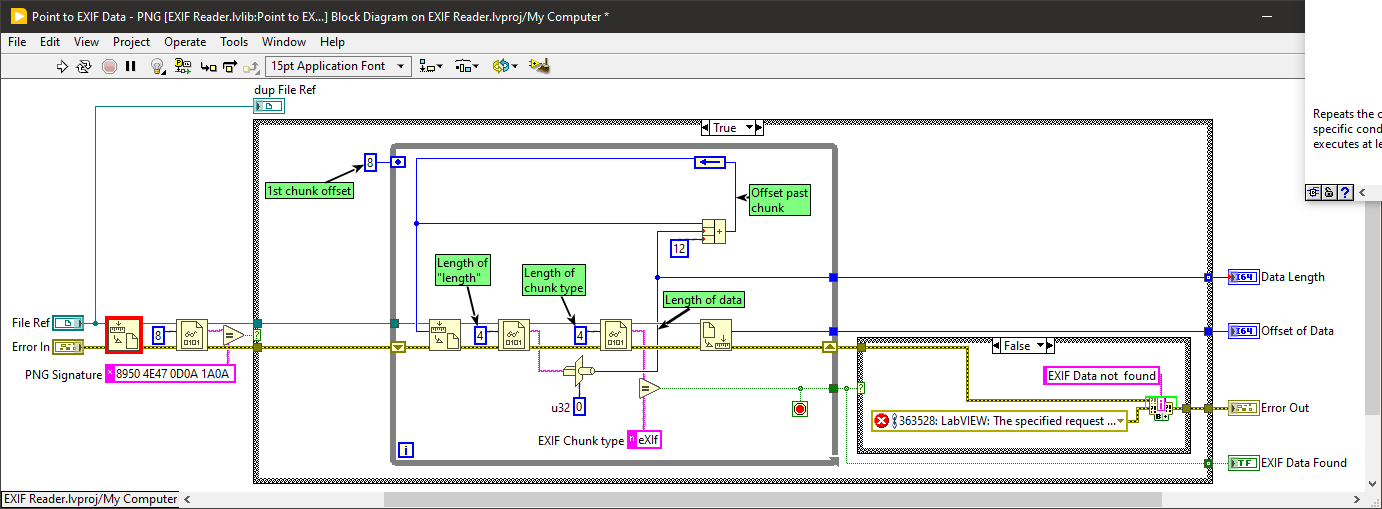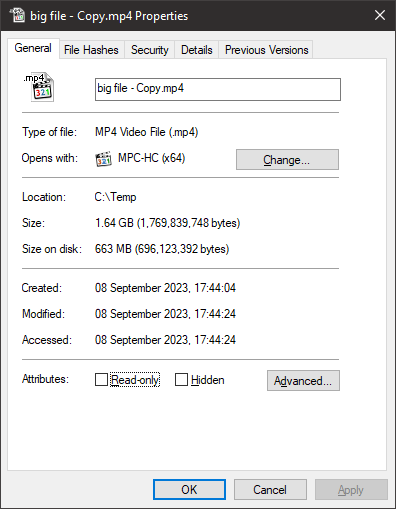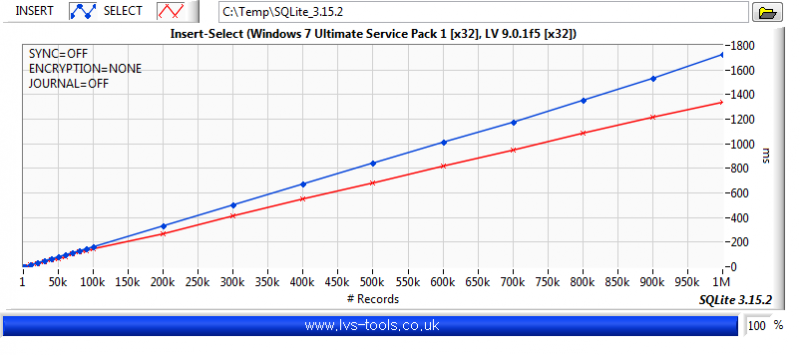-
Posts
4,983 -
Joined
-
Days Won
310
Content Type
Profiles
Forums
Downloads
Gallery
Everything posted by ShaunR
-

Downconversion request (of an interesting example)
ShaunR replied to X___'s topic in LabVIEW General
Back-saved to 2009 Untitled 1.vi BTW. Snippets don't work on Lavag. Always post the VI. -
Nope. Not gonna fly, I'm afraid. This is the problem with LV POOP. I like the bit at the end-a video to show us just how complicated it is. Is this a Test Stand lite? Or is it actually a test framework for unit testing?
-
Nope. But if you are interfacing to TS then changing clusters will break the connector anyway. You are much better off using strings (like JSON or XML) to TS.
-
You could just draw the cluster on a picture control. You could then easily filter out the "reserved". You wouldn't need to change the UI every time it changes and I expect the user doesn't care what the underlying cluster is. Draw Cluster.vi
-

Another Byte Array To String Function question
ShaunR replied to Lucky--Luka's topic in LabVIEW General
What are you expecting? DC is in the extended character set. In the help for the To Lowercase function it states: What it converts to is probably dependent on the code page you are using. -

[CR] EXIF Reader - V1.0.zip
ShaunR replied to paul_cardinale's topic in Code Repository (Uncertified)
Nicely written but doesn't work for me (LabVIEW 2023 64 bit on Windows 10) using this image: . It hangs and never returns in "Point to EXIF Data - PNG.vi". The while loop never terminates as "Get File Position.vi" returns Error 4 (end of file) and there is no check on errors inside the loop so it keeps going and incrementing "Offset past chunk". Additionally, there is no check on the value of the "Offset past chunk" in case it has increased beyond the number of bytes in the file (optional defensive programming). You also have a custom installer which doesn't create all the palette icons correctly. I would recommend you look at the JKI VI Package Manager which is the defacto standard method for creating and installing addon packages. -
Or, in other words, "A Manager". That's all managers are! Your value isn't diminished, you've just been given the opportunity to increase your skill-set.
-
That's the point where most of us switch to consultancy. For that switch, though, you need good personal relationships with customers and be happy with an irregular income.
-
Well. If I were your manager then I'd ask you to find a contractor that can do it in a week and task you with managing them. I feel this is a different point. I am a Systems Engineer and a programming language is a tool I use to engineer a system That is different from what I was saying that languages are pretty much all the same. The latter is a poke at the industry lacking diversity in it's approach to programming and that I (and others) only see a difference in syntax and not really in execution. You might argue that Ladder Programming is a different beast to C/C++ (which it is) but both of those are 50 years old. LabVIEW has more in common with Ladder programming than any of the more modern languages which is why many people struggle when they move from a text based language. There are 32 types of hammers but they are all still hammers. That's how I see programming languages.
-
Are you? What has front end web development to do with Node.js? I'm guessing you have only used Javascript for client-side browser scripting. Don't forget, client-side Javascript is nothing without HTML-itself another language.
-
I don't see why not Javascript syntax and structures are based on Java and C so it's a much easier transition than, say, to embedded Python. The point here is that it's not the language that makes transition difficult. It's the awareness of the limitations of the environment and how to access the hardware.
-
They pretty much are, at the end of the day. When you program in windows, you are programming the OS (win32 API or .NET). It doesn't really matter what language you use but some are better than others for certain things. It's similar with Linux which has it's own ecosystem based on the distributed packages. Where LabVIEW differs is in the drivers for hardware and that is where the value added comes from. The only other platforms that have a similar hardware ecosystem is probably something like Arduino.
-
I always find this kind of question difficult because LabVIEW is just my preferred language. If an employer said we are switching to something else, I'd just shrug my shoulders, load up the new IDE and ask for the project budget number to book to. I think the issue at present isn't really if there is demand for the next 10 years. It's what Emerson will do at the end of this year. You could find that LabVIEW and Test Stand is discontinued this year, let alone in 10.
-

Where do y'all get your (free) artwork for UI elements?
ShaunR replied to David Boyd's topic in User Interface
3) Used all the good ones in other products. I have a load of icon sets from Tucows which is now defunct. Icon sets are difficult to find nowadays. You used to get 200 in a pack. Now they are individual downloads on websites. -
Language ID's SR_IM.vi You may also be interested in some of the other functions instead of asking the user to change the input method.
-
Oh, I am easily replaceable. The other two know how things work in a "white-box", "under-the-hood" manner. I know how stuff works in a "black-box" manner after decades of finding work-arounds and sheer bloody-mindedness.
-
Indeed. Which is what you need.
-
Well. What is your immediate pain? Can you elaborate? Here is an existing file with the first 0x40000000 (d:1073741824) bytes nulled. You can see it only has about 600MB on disk. If I query it I see that data starts at 0x40000000 Now I can do a seek to that location and read ~600 bytes. However. I'm guessing you have further restrictions.
-
It's a common requirement for video editing.
-
You can play with fsultil but Windows (A.K.A NTFS/ReFS) doesn't have the "FALLOC_FL_COLLAPSE_RANGE" like fallocate (which helps with programs that aren't Sparse aware).
-
Indeed. However. Hole punching is much, much faster. If you are talking terabytes, it's the only way really. Set the file to be Sparse. Write 100k zero's to the beginning. Job done (sort of).
-
A 100kB view will not help you truncate from the front. You can use it to copy chunks like mcduff suggested but The issue with what the OP is asking is to get the OS to recognise a different start of a file. Truncating from the end is easy (just tell the file system the length has changed). From the front is not unless you have specific file system operations. On Windows you would have to have Sparse Files to achieve the same as fallocate
-
MySQL, MariaDB, SQLite, PostGreSQL are examples of Relational Databases. They consist of tabular data that can be interrogated by their relationships. Key-Value (or Hash lookup) are another type of database and often referred to as NoSQL databases. No global variables. You may think of the database as a global variable containing all information you have acquired or need to know (it's not really but it will suffice). If these concepts are new to you, then perhaps just concentrate on separating the analysis and display from the acquisition - that is the important part..
-
Not sure about VDM but I did say DVM (Digital Volt Meter). IMO - written abbreviation for "in my opinion": used when you tell someone your opinion, for example in an email. SIC - sic erat scriptum, "thus was it written")[1] inserted after a quoted word or passage indicates that the quoted matter has been transcribed or translated exactly as found in the source text, complete with any erroneous, archaic, or otherwise nonstandard spelling, punctuation, or grammar. It also applies to any surprising assertion, faulty reasoning, or other matter that might be interpreted as an error of transcription. SQLite is pretty fast but huge amounts of raw data are better stored elsewhere and referenced from a relational database. Key-value stores have their place too.
-
There is a limit to how much you can map into memory. BTW. Here is a LabVIEW mmap wrapper for working with files on windows








